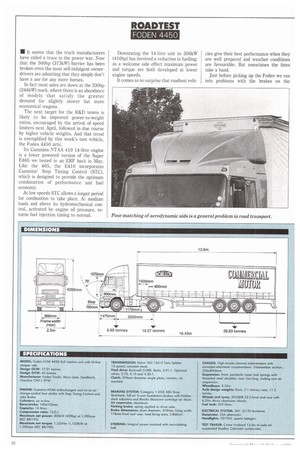• It seems that the truck manufacturers have called a
Page 24

Page 25

If you've noticed an error in this article please click here to report it so we can fix it.
truce in the power war. Now that the 500hp (373kW) barrier has been broken even the most self-indulgent ownerdrivers are admitting that they simply don't have a use for any more horses.
In fact most sales are down at the 330hp (246kW) mark, where there is an abundance of models that satisfy the greater demand for slightly slower but more economical wagons.
The next target for the R&D teams is likely to be improved power-to-weight ratios, encouraged by the arrival of speed limiters next April, followed in due course by higher vehicle weights. And that trend is exemplified by this week's test vehicle, the Foden 4450 artic.
Its Cummins NTAA 410 14-litre engine is a lower powered version of the Super E465 we tested in an ERE back in May. Like the 465, the E410 incorporates Cummins' Step Timing Control (SIC), which is designed to provide the optimum combination of performance and fuel economy.
At low speeds STC allows a longer period for combustion to take place. At medium loads and above its hydromechanical control, activated by engine oil pressure, returns fuel injection timing to normal. Downrating the 14-litre unit to 306kW (410hp) has involved a reduction in fuelling; as a welcome side effect maximum power and torque are both developed at lower engine speeds.
It comes as no surprise that roadtest vehi cies give their best performance when they are well prepared and weather conditions are favourable. But sometimes the fates take a hand.
Just before picking up the Foden we ran into problems with the brakes on the regular CM/Crane Fruehauf triaxle test trailer. Boalloy came to the rescue with the loan of a maximum-length 13.5m top-loader Cabriolet curtainsider demonstration semitrailer. It was not only longer than our trusty 12.2m test trailer; it was taller, so the Foden's fixed roof spoiler, set up to match a standard height trailer, was too low.
Take a look at HGVs travelling along any motorway and you'll see plenty of examples of poor matching. The simple answer would be for roof deflectors to be made adjustable.
During our mandatory stopover at Burton Services on the M6 a perfunctory inspection of the vehicle showed that the gremlins had struck again, this time in the guise of a flat tyre on the inside of the drive axle, caused not by a puncture but a broken valve stem. Closer inspection of the opposite inner wheel revealed an almost identical problem: as we removed the heavy brass valve extension the Schrader valve core blew out.
A phone call to Fodensure, relayed to the nearest ATS depot, soon bought help. Three hours later, having checked all the remaining tyre pressures, we were back on the road, but with no way of knowing how far we had run with the flat.
Michelin suggests that running 25% below optimum tyre pressure increases rolling resistance by about 5%, equating to about 1% on your fuel bill. We calculate that the 25% loss in pressure across the Foden's drive axle (one flat tyre in four) cost us less than a litre of fuel over the whole section. Nonetheless it was not a good start to our three days on the road and in the event the 4450's overall consumption of 41.21lit/100km (6.87mpg) was slightly below par when matched against most of its rivals in the 350-400hp (261-298kW) class.




















































































